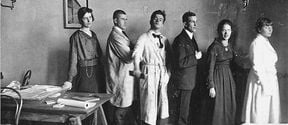Builders of Finland (external link)
The work and influence of Finnish architects has been essential throughout the ages in addressing social and cultural issues.

In 1863, architecture became a part of Helsinki School of Technology’s curriculum. In 1872, Helsinki Technical School became the Polytechnic School. This is considered the beginning of university-level teaching of architecture in Finland.
Over the decades, the location of the school has travelled from Aleksanterinkatu in the centre of Helsinki, via the school building completed in 1877 by the Hietalahti Square, to Otaniemi in Espoo, where it moved to a campus designed by Alvar Aalto in 1964.
In the 2010s, a shift occurred, when Aalto University was established, and the Department of Architecture became a part of the University’s School of Arts, Design and Architecture. In 2018, the school moved into the Väre building at the Otaniemi campus, which was designed by Verstas architects. Part of the school and architecture teaching still takes place in the old architecture department in the A wing of the Candidate Centre.
Over the decades and centuries, architecture curricula, degree structures and facilities have changed, but the core has remained the same. The disciplines of architecture are united by the human relationship with space, the built environment and nature at different scales.
‘Today, the Department of Architecture creates critical thinkers who take responsibility for the resource wisdom and resilience of the built environment -- not forgetting its functional, technical, social and aesthetic quality,’ says Pirjo Sanaksenaho, Head of the Department of Architecture.
‘Since there is no single future towards which we can head, but rather several possible even unimagined futures, multidisciplinary cooperation is the key.’
Over the years, architectural education has expanded into many new areas. Computer-aided design and sustainable development are now essential subjects. There are also optional courses in areas such as humanitarian architecture or social and health architecture. Even more significantly, high quality architectural education has for decades maintained close links with the practical design work of architectural practices. Internationality is also increasingly evident in the teaching staff, which includes several professors and lecturers from outside Finland, and almost a fifth of the department's students are from abroad.
The work and professional skills of Finnish architects have come a long way from the agrarian period of the 19th century to today's information society. The influence of architects has also been essential throughout the ages in addressing social and cultural issues. The legacy of their work can be seen on city streets and in town centres – it is the history and the future of our designed and built environment.
Today, Aalto University's Department of Architecture is an internationally renowned teaching and research unit with close international links and a high level of competitiveness compared to its peer universities. The department and its teachings are geared towards the challenges of future construction, based on Finland's strong architectural heritage. Finnish architecture is globally renowned.
Head of Department of Ardhitecture Pirjo SanaksenahoSince there is not one future we can head towards, but rather several possible futures, multidisciplinary cooperation is needed."
‘I began my studies in architecture in the autumn of 1969 as a triumphant student with six Laudaturs. However, I quickly felt lost, as I did not understand what I was hearing. The critiques were frightening in their authoritarianism: professors spoke, assistants accompanied. Pedagogy was an unknown concept among teachers. Even the architecture of the 1970s seemed anaemic in its rationality. But we were young, and not everything was bleak. I graduated as an architect after an average of eight years of study. I didn't feel ready – but maybe an architect is never ready?’
Aino Niskanen
Course in1969
‘During my studies I spent the summer of 1972 working in an architectural office in England and most of the following year in the USA. The Museum of Architecture offered me a job, but I didn't want to stay there getting mouldy! Instead, I went to Africa to collect data on low cost housing in Kenya for my thesis. I think they thought it was a strange subject, but I graduated in 1975. We were in a hurry to get real jobs.’
Pirkko-Liisa Schulman (Louhenjoki)
Course in 1969
‘The year 1975 was not the best time to start studying architecture. There was no praise for the teaching – if there was any at all. Encouragement was not part of the toolbox, and the verb 'to empower' had not yet been invented. Fortunately, there were the occasional guest lectures by someone like Juhani Pallasmaa or Juha Leiviskä, and we listened with bated breath: ‘So this world does exist!’ Well, there was, of course, the history of architecture, and there was some real teaching. The highlights of the year were always the excursions within Finland, which I must have taken part in more than ten times, and I got to know the built faces of the home country. You got a first-hand experience of what architecture can be.’
Jouni Kaipia
Course in 1975
‘I enjoyed every moment of freedom that my studies gave me, until I reached my limit in the upper courses: I no longer felt that I was getting anything out of my studies, after I had completed every possible course in the history of architecture. We were discussing the teaching of that period at a course meeting recently, and the general opinion seemed to be that it was precisely in history of architecture where the department excelled at that time as the best distributor of knowledge and skills.’
Esa Laaksonen
Course in 1976

The work and influence of Finnish architects has been essential throughout the ages in addressing social and cultural issues.



